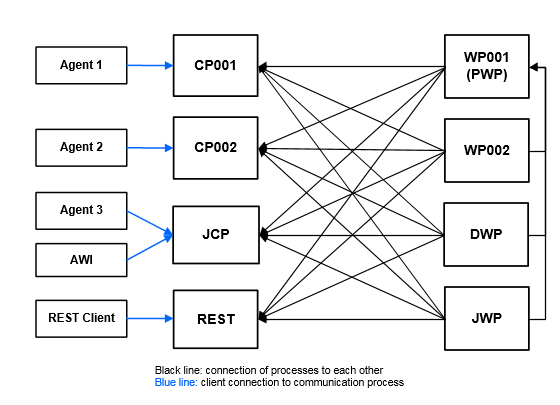Multi-Server Operations
The Automation Engine is based on multi-server operations. Having several instances of the Automation Engine operating in parallel offers higher reliability and allows the setup of fully scalable AE systems that grow according to the performance requirements.
The server processes, that is the work and communication processes are the technical foundation of the Automation Engine. The server processes are not limited to a single node/computer, thus boosting both efficiency and reliability through their distribution over several computers.
In theory, you can activate an unlimited number of server processes. Adding processes allows you to adjust to growing strain on the AE system. If numerous agents are logged on and you have many Automic Web Interface instances running, the number of communication processes can be increased. If the challenge lies in the large number of tasks that have to be processed, the number of work processes can be increased.
Important!
-
To have a multi-server operation, the computers on which the server processes run must run on the same platform. For example, two computers with Linux. A combination of computers with different UNIX derivatives or a mixture of UNIX and Windows cannot be used.
-
To avoid discrepancies when using more than one computer, their times should be adjusted to each other. Although the server processes measure the time offset and balance it, there are still time gaps as they only do so in particular intervals.
Structure of an Automation Engine System
The charts below show the IP connections and message flow of the fundamental structure of an AE system. This particular structure has two work processes (WP1, WP2), two communication processes (CP1, CP2), a Java Communication Process (JCP), a REST process (REST), three agents (Agent1, Agent2, Agent3), an Automic Web Interface (AWI) and a REST client. One of the work processes is available for instances of the Automic Web Interface (DWP), one for Java applications (JWP, JCP, REST).

The work processes access a shared work queue (MQWP). Each communication and REST process has its own queue (MQCP001, MQCP002, MQCP003, MQCP004). Special processing steps for logging and resource administration are managed through the queues MQOWP and MQRWP. The MQSRV queue is used for AE system process management. MQMEM is the cache for running activations. MQLS is a local memory for various management tasks of the server processes.

Work, Communication, and REST Processes
- CP001: First Communication Process
- CP002: Second Communication Process
- WP001: First Work Process
- WP002: Second Work Process
- DWP: Dialog Process
- JWP: Java Work Process
- JCP: Java Communication Process
- REST: REST Process
Queues for Communication and REST Processes
- MQnCP001: Queue for First Communication Process
- MQnCP002: Queue for Second Communication Process
- MQnCP003: Queue for Java Communication Process
- MQnCP004: Queue for REST Process
Queues for Work Processes
- MQnPWP: Queue for primary Work Process
- MQnWP: Queue for Work Processes
- MQnDWP: Queue for Dialog Processes
- MQnOWP: Queue for Outputs
- MQnRWP: Queue for Resources
- MQnJWP: Queue for Java Work Processes
- MQnAUT: Queue for Authentication (JWP)
- MQnUTL: Queue for Utilities (JWP)
Other Queues
- MQSRV: Queue for Server Management (Processes)
- MQMEM: Queue for Activation Sequences
- MQLS: Queue for Local Operations
See also: